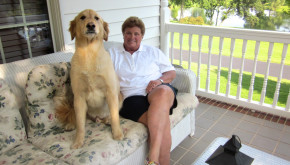
by Margot Cumming, University of Wisconsin undergraduate
Thirty miles down Highway 40, in southern Virginia, the land rolls gently with endless rows of emerald green crops. Billboards proclaim:
“Peanuts – whole sale and retail! Tourists welcome!”
“We’re not nuts, but we sell ‘em”
The neighboring fields gaze up at a cloudless sky, as Debbie Clay zips us around on her gator.
“This land has been in my family for over a hundred years. My daddy’s daddy used to grow tobacco.” She points to a pond in front of the white house, under the watchful eye of two lazy-eyed horses in paddock, “The land got divided up between the kids, right down through the pond.”
Debbie Clay and her husband, Sam, own 130 acres of the original Clay plantation, which they lease to other crop farmers in the area. This land is much like their neighbors – purely agriculture. But recently, Clay has added diversity to her acreage.
“They wanted to put in a regional landfill,” Clay explains, “We put up a bid, and now we got it.”
The 250 acres that Clay acquired in 2003 was a type of land that was considered woodland: vegetated with trees and shrubs. And with that purchase came a choice.
“Forest land is disappearing. There is development everywhere,” explains Clay about her decision to keep the land in timber. “Hunting clubs come a long way to use this land. People appreciate it. Plus, we use it too!”
This area is crisscrossed with ATV and horse trails that the Clays maintain and the neighbors use. The forest shows personal signs of the family as well: turkey feathers are strung with care from the trees by grandchildren, and a gazebo atop a hill is overseen by a friendly, life-sized bear carving.
The Clays first harvested timber from this piece of land shortly after they purchased it, in 2004. It is now growing thickly with white pine that was planted after the first cut. Despite evident enthusiasm, Clay is new to the role of forest manager, and relies on her county resources for information.
“It hasn’t been a challenge at all – it’s been kinda fun.” Clay says, “I went to the first round table and I’m just learning so much.”
Clay recently attended a meeting hosted by the Virginia Women Landowner Conservation Program, or “round table” for short. She proudly shows a folder stuffed with pamphlets, information sheets and contact info. Clay has been in contact with a recommended forester, and has a sheet full of scribbled questions. She hopes to thin the stands soon, and cut again in the future.
“It pays to plan – talk to professionals. They will look out for your interests – tell you the right information and when to cut.”
Clay and her husband see the new land as an investment in the future. They can see the value of good management and the longevity of her land.
“We’ll cut once more in our lifetime, and then our kids can cut in theirs – it passes on and on,” says Mr. Clay.
The value of forested land isn’t lost on those keen for development. The Clays are burdened multiple times a year with mailings and phone calls of people looking to buy the land. Without a second glance to her husband, Clay answers:
“I’m not doing it.”
Despite having Sam at her side for support and advice, the land is solely in her name – an ownership that she holds with pride.
“I think a woman needs something in her name – it’s not like the old days, you know?” says Clay and nudges me to remember that life lesson.
The future is bright for the parcel of land that was once destined for a landfill. A mostly filled-out American Forest Foundation application shows that Clay hopes the land will become a designated Tree Farm in the near future. Clay is eager to learn more and stay involved as her trees mature. Soon a thinning will probably take place, but the trees still have many years before they are ready to be harvested again.

